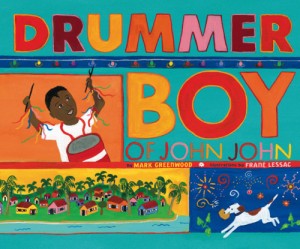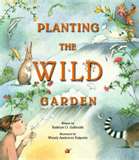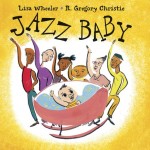 Maybe it’s the vibrant art or maybe it’s the tropical setting of Trinidad, but on this snowy March day, I am in love with Drummer Boy of John John by Mark Greenwood with illustrations by Frane Lessac. Knowing that it’s a biography (so it hits the Common Core standard of Range of Reading) that incorporates music and art makes me love it even more.
Maybe it’s the vibrant art or maybe it’s the tropical setting of Trinidad, but on this snowy March day, I am in love with Drummer Boy of John John by Mark Greenwood with illustrations by Frane Lessac. Knowing that it’s a biography (so it hits the Common Core standard of Range of Reading) that incorporates music and art makes me love it even more.
It’s almost time for Carnival and everyone in Winston’s town is getting ready to celebrate with calypso music. Winston wishes he were in a band, because the best band in the parade will get free rotis from the Roti King. (Is your Craft and Structure Common Core Standard alarm ringing? Lots of interesting word choices in this book!) But Winston has no gourds full of seeds that go “shoush-shap/ shukka-shac” and no bamboo to pound on the ground with a “click clack/ rappa-tap” (Check Print Concepts off on your Common Core score card). When Winston throws his mango pit into the junkyard, he hears a “pong ping pang” as the pit hits old metal. Winston makes his own instrument from the dented metal containers – the first steel drum. Winston’s friends hear this music and form a junkyard band. They paint pots, pans, tins, and cans rainbow colors and experiment with the dents and bumps in the metal to make different pitches. Winston’s band is crowned the best band in the Carnival parade, so they all feast on rotis and mango lemonade.
This book has so many tie-ins for art, music, and social studies. (I wish I’d found it a month ago, so I could’ve used it for Carnival/Mardi Gras, but it’s a fun lesson any time of year.) Students can use recycled cans, jars, bottles and containers to make their own instruments. Paint them in the tropical rainbow colors Lessac used in her art. Play a clip of steel drum music for students (you can get cd’s from your local library or use this Youtube clip: Steel Drums in Trinidad and Tobago. Bring in mangos for students to taste after they try dancing under the limbo pole like the Roti King does. Use your recycled instruments to play a “listen and repeat” rhythm game to build listening skills. Winston Simon began with junk from the junkyard and ended up touring London and Paris with the Trinidad All Stars Percussion Orchestra. Who knows where tin cans and this inspirational book might take your students?
For more information about the author, visit: markgreenwood.com.au.
For more information about the illustrator, visit: franelessac.com


